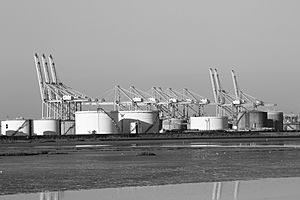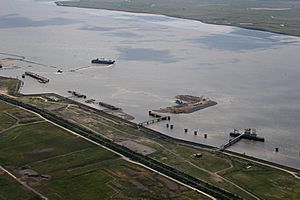London Gateway facts for kids
Quick facts for kids London Gateway |
|
|---|---|
 |
|
| Lua error in Module:Location_map at line 530: "<strong class=\"error\"><span class=\"scribunto-error\" id=\"mw-scribunto-error-0\">Lua error in Module:Location_map at line 420: attempt to index field 'wikibase' (a nil value).</span></strong>" is not a valid name for a location map definition. | |
| Location | |
| Country | United Kingdom |
| Location | Thurrock, Essex |
| Coordinates | 51°30′19″N 0°29′25″E / 51.5052°N 0.4902°E |
| Details | |
| Opened | 2013 |
| Owned by | DP World |
| Type of harbor | Deep water |
| Available berths | 3 |
| Location | Essex |
|---|---|
| Proposer | DP World |
| Website | https://www.londongateway.com/ |
| Status | operating |
| Type | Sea |
| Cost estimate | £1.5 billion |
| Start date | 2008 |
| Completion date | 2013 |
| Geometry | KML |
DP World London Gateway is a very important port in the United Kingdom. It's part of the bigger Port of London. This huge facility opened in November 2013. It's not just a port; it's also a big area for warehouses and distribution centers.
The port is located on the north side of the River Thames in Thurrock, Essex. This is about 30 miles (48 km) east of central London. Because it's a deep-water port, it can handle some of the largest container ships in the world. These ships carry goods from all over, connecting London Gateway to more than 90 ports in 51 countries. This includes places like Asia, Australia, the US, South America, and Africa.
DP World built this new port to help London handle more container shipping. This was important because Britain needed more places to manage the growing number of containers arriving. Construction started in February 2010. The port and its logistics park were built in different stages. It started with three berths (places where ships dock), and there's room to build three more. In 2021, DP World even announced plans for a fourth berth.
The first part of the port opened on November 6, 2013. The first ship to dock was the 58,000-tonne MOL Caledon. It was carrying fruit and wine from South Africa.
After the port was built, the Logistics Park started to grow. Big companies like UPS and Lidl have opened large facilities there. UPS opened a 32,000-square-meter package-sorting center in 2018. Lidl, a German grocery store, started using a warehouse at London Gateway in March 2017.
The port can handle 3.5 million containers (TEU) each year. In 2021, it handled 1.8 million TEU, and this number keeps growing!
Contents
The Port: How it Works
Smart Technology and Equipment
DP World London Gateway Port uses a lot of smart technology. It's called a "semi-automated" port. This means it uses robotic, automated cranes to help move containers. These robots manage containers as they go from the ships to trucks or trains.
There are 12 huge quay cranes (also called ship-to-shore cranes) along the 1200-meter long dock. These cranes are among the biggest in the world. They can reach across the widest ships and lift up to four containers at once! They can lift cargo weighing up to 80 tonnes. These cranes help the port handle the largest container ships, which can be up to 400 meters long and carry 24,000 TEUs. A TEU is like a standard 20-foot container.
The port currently has three deep-water berths, but it can expand to six in the future.
The facility also uses 60 automated stacking cranes. These cranes help organize containers in the storage areas. There are 180 bays where trucks can pick up or drop off containers.
Special vehicles called straddle carriers move containers between the automated stacking area and the quay cranes. Other vehicles like terminal tractors move containers to the port's rail terminal and inspection areas.
A smart gate system helps trucks enter the port smoothly. Drivers book a time slot, and the system guides them. This helps trucks get in and out very quickly. In 2016, trucks spent only about 35 minutes on average at the port.
Easy Road Access
Getting to London Gateway by road is easy. It's connected to the A13 and the M25 motorway. DP World London Gateway has invested a lot of money to improve the roads around the port. They added more lanes to junctions and moved a roundabout to make access better. They also helped fund the widening of the A13.
There's also a bus service for employees from nearby towns like Chafford Hundred, Grays, and Stanford-le-Hope.
Reliability and Safety
The technology at DP World London Gateway makes it a very safe port. The automated areas mean that people don't have to work too closely with stacks of containers, which is safer. This also means the port can handle bad weather very well. It has only closed for a few hours in several years due to weather.
Global Shipping Connections
London Gateway has grown its customer base a lot. It now offers shipping services to and from 51 countries and over 91 ports worldwide. Big shipping groups like THE Alliance use London Gateway for their services to and from Asia, including China, Vietnam, and Thailand. There are also weekly services to places like South America, the Caribbean, the United States, Australia, South Africa, and the Mediterranean.
The Future of the Port
The port plans to expand with more berths (four, five, and six) as demand grows. When fully built, it will have six deep-sea berths, 2700 meters of quayside, and 24 quay cranes. This will allow it to handle 3.5 million TEUs each year. It's estimated that a fully operational port will save 65 million HGV-miles and take 2,000 trucks off the road every day. This is good for both the economy and the environment!
London Gateway has also shown interest in becoming a freeport after the UK left the EU. This would mean special rules to make trade easier.
Rail Terminal: Trains for Trade
The rail terminal at DP World London Gateway is one of the longest in the UK. It's located right inside the port's secure area.
Trains can access the terminal through a connection to the Tilbury Loop of the London, Tilbury and Southend line. The port has 25 km of double track. This allows trains up to 750 meters long to be loaded and unloaded right next to the container areas.
Rail companies like DB Cargo UK and Freightliner run daily intermodal trains. These trains connect the port to other parts of the UK, like the West Coast Main Line. The rail lines are designed to carry tall containers, even those that are 9 feet 6 inches high.
The rail terminal is operated by GB Railfreight. It uses three rail-mounted gantry cranes to move containers between the ground and the train wagons.
An exciting event happened on April 10, 2017: the first rail freight service from the UK to China left from London Gateway! This journey took 19 days, passing through many countries like France, Germany, Russia, and Kazakhstan, before reaching Yiwu in China.
DP World London Gateway also has plans to build a second rail terminal in the future.
Logistics Park: Warehouses and Distribution
The DP World London Gateway Logistics Park is a huge area of land, about 9.25 million square feet. It's ready for new warehouses and distribution centers to be built. It offers many options for businesses to store and move their goods. They can either use buildings that are already built or work with the port team to design custom buildings. These buildings can be used for manufacturing, distribution, or storage.
Quick Planning Permission
The Logistics Park has something special called a "Local Development Order." This means that planning permission for new buildings can be approved very quickly, sometimes in just 28 days! This order was approved in November 2013. It's designed to speed up projects. For example, UPS got planning permission for its facility in just 17 days! This order is thought to be the largest of its kind in the UK.
Helping Businesses with Supply Chains
In 2016, DP World London Gateway created a special team to help businesses with their supply chains. This team works with companies like retailers and manufacturers to help them improve how they move and distribute their products.
Lidl's Facility
The first building completed at the Logistics Park was the DP World London Gateway Logistics Centre. It even received a special "Planet First" award for being environmentally friendly. In December 2016, it was announced that Lidl, the grocery retailer, would start using this center. Lidl began operating there in March 2017.
UPS's Hub
In May 2018, UPS opened a large, highly automated parcel sorting hub at the Logistics Park. This 32,000-square-meter facility acts as a main hub for UPS in the UK. It also connects to UPS's global transport network. It can process about 30,000 packages every hour!
History of London Gateway
DP World London Gateway is built on the former Shell Haven site, which was an oil refinery that closed in 1999. There are other ports nearby, like Thamesport and Tilbury container port.
DP World received government approval to build the port and logistics park in May 2006. The Prime Minister at the time, Gordon Brown, saw it as one of the key projects for developing the Thames Gateway area.
In May 2008, the government gave DP World London Gateway a "Harbour Empowerment Order." This gave the new port official legal powers and recognized it as a proper authority.
The port's development faced some challenges, especially during the financial crisis around 2009. However, DP World pushed forward, and construction began in 2010.
Since opening in 2013, the port has steadily grown. A big moment came in March 2017 when THE Alliance, a group of major container shipping companies, decided to use London Gateway for their UK stops on Asia-Europe routes. This was very important because about 17% of all UK imports come from Asia. When the port first opened, many shipping companies were already using other ports, but London Gateway has successfully attracted more and more business.
In 2021, London Gateway handled 1,804,871 TEUs, which was a 15% increase from the year before!
Building the Port
Construction of London Gateway started in February 2010. It was a huge project that took several years. The first step was a £400 million project to dredge (dig up) the riverbed and reclaim land.
The first three of the giant quay cranes arrived in March 2013. These cranes were made in Shanghai and weigh 1848 tonnes. They are incredibly tall, even taller than the London Eye! They can reach across 25 containers on a ship and lift up to 80 tonnes.
By September 2015, two of the six berths were ready. The third berth opened on April 1, 2017.
Policing the Port
The London Gateway Port has special rules for its security. The port authority can ask a justice of the peace to appoint constables to form a police force for the port. These officers would have all the powers of a constable within the port area. If they chase someone from the port, they keep their powers of arrest. The local police force for the area is Essex Police.




